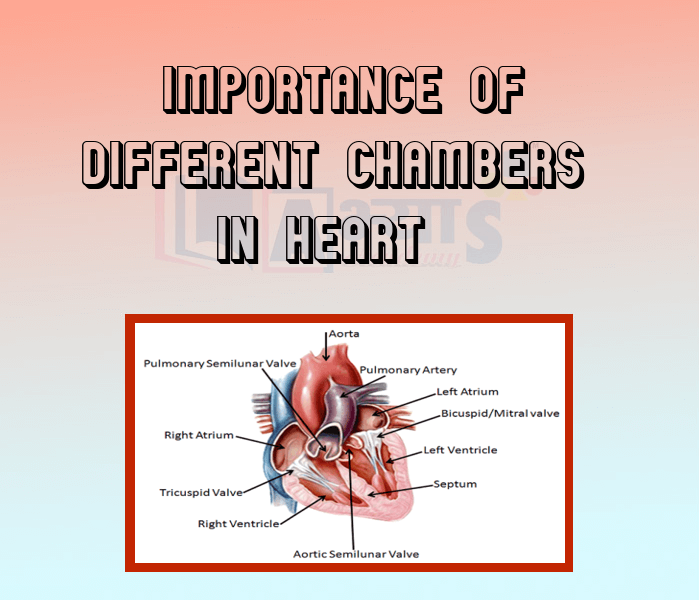Importance of Different Chambers in Heart










Importance of Different Chambers in Heart
Chambers in the heart: The heart is divided into chambers in order to prevent the mixing of oxygenated blood with deoxygenated blood. A complete vertical partition of the heart into left and right chambers ensures a complete separation of oxygenated and deoxygenated blood. This type of partition is seen in animals having a double circulation system with two circuits. These animals (e.g. mammals, birds and crocodiles) have lungs.
In one circuit blood flows between the heart and the lungs and in the second circuit it flows between the heart and the body. The heart has four chambers: two atria (often called auricles) and two ventricles. Such a heart is called double heart. This type of complete separation into chambers provides an ample supply of oxygen to all parts of the body. These animals are quite active, so they have a high rate of respiration and require an efficient supply of oxygen. Birds and mammals, being warm blooded, need to spend energy to regulate their body temperature. This also requires oxygen.
Some vertebrates do not use energy for temperature regulation. Their temperature fluctuates with that of the environment and we call them cold blooded. In these animals (except crocodiles) there is some mixing of oxygenated and deoxygenated blood in the heart. This does not harm the animals as their energy demands are not very high. In amphibians the heart is three chambered, having two atria and a single ventricle. Such a heart is called ‘transitional heart’. In most reptiles there are two atria and an incompletely divided ventricle.
Fish have a single circulation system. Their heart is two chambered, having one atrium and one ventricle. Such a heart is called ’single heart’. The fish heart receives and pumps only impure blood. The impure blood goes to the gills for oxygenation and from there it goes to different parts of the body. The impure blood returns to the heart for being pumped out to the gills. Therefore, the fish heart is also called ‘venous heart’.
The heart of fish is also called ______________________ . | |||
| Right Option : A | |||
| View Explanation | |||
In amphibians the heart is ____________________________ chambered, having two atria and a single ventricle. | |||
| Right Option : A | |||
| View Explanation | |||
The human heart has____________________ chamber present | |||
| Right Option : B | |||
| View Explanation | |||
Students / Parents Reviews [10]
My experience with Abhyas academy is very good. I did not think that my every subject coming here will be so strong. The main thing is that the online tests had made me learn here more things.

Hiya Gupta
8thIt was good as the experience because as we had come here we had been improved in a such envirnment created here.Extra is taught which is beneficial for future.

Eshan Arora
8thAbout Abhyas metholodology the teachers are very nice and hardworking toward students.The Centre Head Mrs Anu Sethi is also a brilliant teacher.Abhyas has taught me how to overcome problems and has always taken my doubts and suppoeted me.

Shreya Shrivastava
8thIt has a great methodology. Students here can get analysis to their test quickly.We can learn easily through PPTs and the testing methods are good. We know that where we have to practice

Barkha Arora
10thMy experience with Abhyas is very good. I have learnt many things here like vedic maths and reasoning also. Teachers here first take our doubts and then there are assignments to verify our weak points.

Shivam Rana
7thMy experience was very good with Abhyas academy. I am studying here from 6th class and I am satisfied by its results in my life. I improved a lot here ahead of school syllabus.

Ayan Ghosh
8thAbhyas is a complete education Institute. Here extreme care is taken by teacher with the help of regular exam. Extra classes also conducted by the institute, if the student is weak.

Om Umang
10thOne of the best institutes to develope a child interest in studies.Provides SST and English knowledge also unlike other institutes. Teachers are co operative and friendly online tests andPPT develope practical knowledge also.

Aman Kumar Shrivastava
10thAbhyas Methodology is very good. It is based on according to student and each child manages accordingly to its properly. Methodology has improved the abilities of students to shine them in future.

Manish Kumar
10thA marvelous experience with Abhyas. I am glad to share that my ward has achieved more than enough at the Ambala ABHYAS centre. Years have passed on and more and more he has gained. May the centre flourish and develop day by day by the grace of God.
